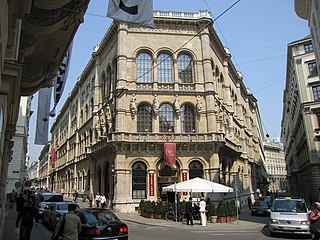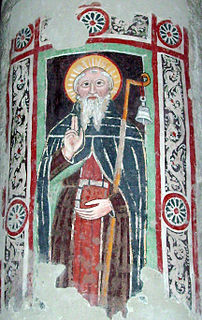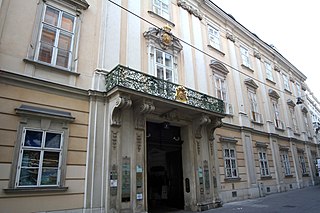
The Freyung is a triangular public square in Vienna, located in the Innere Stadt first district of the city.

The Freyung is a triangular public square in Vienna, located in the Innere Stadt first district of the city.
The square originally lay outside the Roman fortification walls of Vindabona. In the 12th century, Irish monks arrived by invitation of Duke Henry II of Austria to build a monastery. The monastery is called Schottenkloster, meaning Scottish Monastery, as Ireland at that time was known as New Scotland. The square around Schottenkloster was known as "bei den Schotten" ("at the Scots").

The name Freyung has its origin from the old German word "frey", meaning "free". Since the monastery had the privilege of freedom from ducal authority, as well as the right to grant protection to fugitives, the square gained its name from its proximity to the Schottenkloster. The priory was added to the monastery in 1773 and became popularly known as Schubladkastenhaus (Chest of Drawers House) because of its shape.
The Freyung became an important market square, where various street artists and entertainers performed for their living. One of these performances was the Wiener Hanswurst (Viennese Fool) by Josef Stranitzky.
Since the Hofburg Imperial Palace was not far, in the 17th and 18th centuries many aristocrats established their city residences at the square, as well as the neighbouring Herrengasse.
In 1856, the houses between the Freyung and the adjacent square Am Hof were demolished to broaden the street between them. In the late 19th century banks and other financial houses also moved into the area and established headquarters.
Furthermore, the Austria-Brunnen fountain, erected in 1844-1846 by Ludwig Schwanthaler in honour of Emperor Ferdinand I of Austria, sits in the middle of the square.


The Vienna Ring Road is a 5.3 km circular grand boulevard that serves as a ring road around the historic Innere Stadt district of Vienna, Austria. The road is located on sites where medieval city fortifications once stood, including high walls and the broad open field ramparts (glacis), criss-crossed by paths that lay before them.

The Schottenstift, formally called Benediktinerabtei unserer Lieben Frau zu den Schotten, is a Catholic monastery founded in Vienna in 1155 when Henry II of Austria brought Irish monks to Vienna. The monks did not come directly from Ireland, but came instead from Scots Monastery in Regensburg, Germany. Since 1625, the abbey has been a member of the Austrian Congregation, now within the Benedictine Confederation.

The Graben is one of the most famous squares in Vienna's first district, the city center. It begins at Stock-im-Eisen-Platz next to the Palais Equitable, and ends at the junction of Kohlmarkt and Tuchlauben. Another street in the first district is called Tiefer Graben. It is crossed by Wipplinger Straße by means of the Hohe Brücke, a bridge about 10 meters (33 ft) above street level.

The Schottenkirche is a parish church in Vienna attached to the Schottenstift, founded by Hiberno (Irish)-Scots Benedictine monks in the 12th century. In 1418, the Duke Albert V of Austria transferred it to the German-speaking Benedictine monks from the Melk Abbey during the Melker Reform initiated after the Council of Constance. The church was elevated to the rank of Basilica Minor in 1958.

Café Central is a traditional Viennese café located at Herrengasse 14 in the Innere Stadt first district of Vienna, Austria. The café occupies the ground floor of the former Bank and Stockmarket Building, today called the Palais Ferstel after its architect Heinrich von Ferstel.

The Hiberno-Scottish mission was a series of expeditions in the 6th and 7th centuries by Gaelic missionaries originating from Ireland that spread Celtic Christianity in Scotland, Wales, England and Merovingian France. Celtic Christianity spread first within the Kingdom of Dál Riata, within Ireland and the western coast of Scotland. Since the 8th and 9th centuries, these early missions were called 'Celtic Christianity'.

Palais Esterházy is a baroque palace in Vienna, Austria, owned by the noble Esterházy family. It houses a famous and popular restaurant in the former wine cellars, called Esterházykeller.

Palais Harrach is a Baroque palace in Vienna, Austria. It was owned by the noble Harrach family. The building was extensively renovated and restored in the late 1990s, and it houses offices and shops today.

Palais Kinsky is a Baroque palace in central Vienna, Austria. It was originally built for Count Wirich Philipp von Daun, the garrison commander whose son Leopold became a Field Marshal of Empress Maria Theresa. The palace was later bought by the Kinsky family of Bohemia, and it is sometimes called the Palais Daun-Kinsky.

Palais Epstein is a Ringstraßenpalais in Vienna, Austria. It was built for the industrialist and banker Gustav Ritter von Epstein. The architect was Theophil Freiherr von Hansen, who also designed the adjacent Austrian Parliament Building. Unlike traditional Baroque noble palaces in Vienna, Palais Epstein was built in the late 19th century and is therefore considered a Ringstraßenpalais. It is up to five storeys high and built in the neo-renaissance style typical of its time.
The Herrengasse is a street in Vienna, located in the first district Innere Stadt.

The Minoritenplatz is one of the oldest public squares in Vienna. It is located in the first district Innere Stadt, and is dominated by the Minoritenkirche church, after which the square is named. The church itself was constructed by the Greyfriars (Minoriten), after the Austrian Duke Leopold VI of Austria invited them to Austria in 1224. Since the square is in direct proximity to the Hofburg Imperial Palace, a number of aristocratic families took up residence in the square from the 16th to the 18th century.

The House of Harrach is an old and influential Bohemian and Austro-German noble family. The Grafen (Counts) of Harrach were among the most prominent families in the Habsburg Empire. As one of few mediatized families, it belongs to high nobility.
Schottenklöster is the name applied to the monastic foundations of Irish and Scottish missionaries in Continental Europe, particularly to the Scottish Benedictine monasteries in Germany, which in the beginning of the 13th century were combined into one congregation whose abbot-general was the Abbot of the Scots monastery at Regensburg.

Freiherr Heinrich von Ferstel was an Austrian architect and professor, who played a vital role in building late 19th-century Vienna.

Palais Porcia is a former urban residence in the western quarter of the Innere Stadt of Vienna, Austria. It stands at 23, Herrengasse between Palais Kinsky and Palais Trautmansdorff and across Palais Harrach. The palace was built in 1546 for the descendants of Count Gabriel von Salamanca-Ortenburg. It was representative of the simple Renaissance style that emerged in Vienna in the middle of the 16th century. In the 17th and later centuries it was extensively remodelled in Baroque and Rococo styles but the inner court still contains an early Renaissance arcade. As of 2010, Palais Porcia houses the Administrative Library of the Austrian Federal Chancellery.

Alservorstadt was an independent municipality until 1850 and is since then divided between Josefstadt and Alsergrund, the 8th and 9th districts of Vienna, respectively.

Schloss Rohrau is a castle in the town of Rohrau in Lower Austria, bordering on Burgenland. The building houses the art collection of the counts of Harrach.

The following outline is provided as an overview of and topical guide to Vienna:

Palais Ferstel is a building located in Herrengasse street, in Vienna. It was originally built for the Austrian National Bank and stock exchange in 1860, and from 1878 served as head office of the Austro-Hungarian Bank. It was constructed by Baron Heinrich von Ferstel. The design of the building is reminiscent of early Florentine Renaissance architecture.